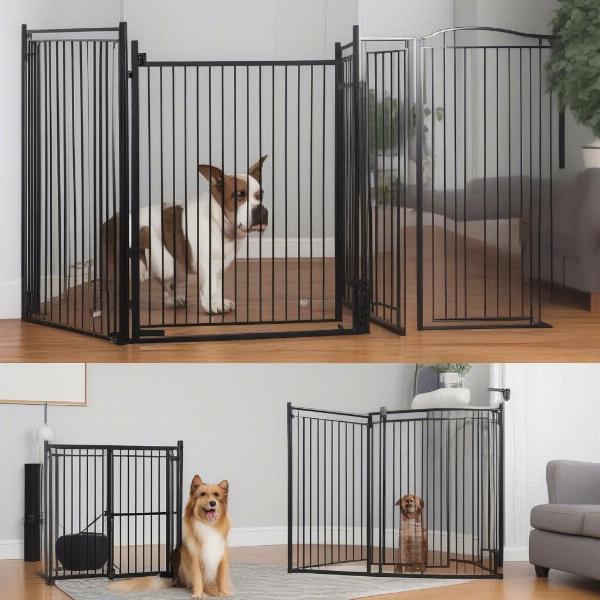Indoor pet fences offer a safe and effective way to manage your dog’s movement within your home without resorting to traditional crates or cages. They provide a designated space for your dog, preventing access to certain areas while still allowing freedom to roam and play. Whether you’re potty training a puppy, protecting your furniture from a teething adolescent, or managing a multi-dog household, an indoor pet fence can be a valuable tool.
Choosing the Right Indoor Pet Fence for Your Dog
Selecting the right indoor pet fence depends on several factors, including your dog’s size, breed, temperament, and the layout of your home. Consider the following:
- Freestanding Gates: These portable gates are ideal for blocking off doorways, hallways, or staircases. They are easy to set up and move as needed.
- Playpens: Perfect for puppies and smaller dogs, playpens create a dedicated space for play and rest.
- Modular Pet Barriers: These versatile systems consist of interlocking panels that can be configured to create custom enclosures of various shapes and sizes. They are great for larger areas or unusually shaped rooms.
- Wireless Fences: These systems use radio signals to create a virtual boundary. A transmitter sends a signal to a receiver collar worn by your dog. When your dog approaches the boundary, the collar emits a warning tone, and if they cross it, a mild static correction is delivered.
 Types of Indoor Pet Fences
Types of Indoor Pet Fences
Benefits of Using an Indoor Pet Fence
Indoor pet fences offer numerous benefits for both you and your furry friend:
- Safety: They prevent access to hazardous areas such as kitchens, stairs, and rooms with potentially dangerous objects.
- House Training: Confining a puppy to a designated area can help with potty training by preventing accidents throughout the house.
- Furniture Protection: Indoor fences can protect your furniture from chewing and scratching, especially during a dog’s teething phase.
- Managing Multi-Dog Households: They can be used to separate dogs who don’t get along, preventing fights and reducing stress.
- Creating a Safe Space: An indoor pet fence can provide a secure and comfortable den-like space for your dog to relax and retreat when they feel overwhelmed or need some quiet time.
Training Your Dog to Use an Indoor Pet Fence
Introducing your dog to an indoor pet fence should be a gradual and positive experience. Start by placing the fence in the desired location and allowing your dog to explore it freely. Lure them into the enclosed area with treats and praise. Never force your dog into the fence, as this can create negative associations. portable pet enclosures dog can be a good starting point for training.
For wireless fences, begin with the lowest correction setting and gradually increase it as needed. Always supervise your dog during the initial training period.
“Consistency is key when training your dog with an indoor fence,” says renowned canine behaviorist, Dr. Emily Carter. “Positive reinforcement and patience will help your dog adjust to their new boundaries quickly and comfortably.”
Maintaining Your Indoor Pet Fence
Regular cleaning and maintenance are essential to ensure the longevity and effectiveness of your indoor pet fence. Wipe down freestanding gates and playpens with a pet-safe cleaner. Check modular barriers regularly for loose connections or damaged panels. For wireless fences, replace the batteries in the collar as needed.
Conclusion
Indoor pet fences provide a valuable tool for managing your dog’s behavior and creating a safe and comfortable environment within your home. By carefully considering your dog’s needs and choosing the right type of fence, you can ensure a positive experience for both you and your furry companion. in training vest for dogs can be useful during the training process. Remember to introduce the fence gradually and use positive reinforcement to create a positive association. With proper training and maintenance, an indoor pet fence can be a valuable addition to your home.
FAQs
-
Are indoor pet fences cruel? No, when used correctly, indoor pet fences are not cruel. They provide a safe and contained space for your dog without resorting to confinement.
-
Can I use an indoor pet fence for a puppy? Yes, indoor pet fences are particularly helpful for puppies during potty training and for preventing destructive chewing.
-
What is the best type of indoor pet fence for a large dog? Modular pet barriers or wireless fences are generally more suitable for larger dogs.
-
How do I clean my indoor pet fence? Use a pet-safe cleaner and wipe down the fence regularly.
-
What if my dog jumps over the indoor pet fence? Ensure the fence is the appropriate height for your dog’s size and breed. Consider a taller fence or a different type of indoor confinement solution if your dog consistently jumps over the fence.
-
Can I use an indoor pet fence to separate dogs? Yes, indoor pet fences can be used to separate dogs who don’t get along, reducing conflict and stress. portable outdoor dog fence may offer additional options.
-
How do I train my dog to use a wireless pet fence? Start with the lowest correction setting and gradually increase it as needed. Always supervise your dog during the initial training period.
ILM Dog is a leading international pet website dedicated to providing expert advice and resources on all aspects of dog care and breeding. We offer valuable information on dog breeds, health, training, nutrition, grooming, and much more. electric fense for dogs can provide additional safety. Whether you’re a seasoned dog owner or just starting your journey, ILM Dog is your go-to resource for all things canine. Contact us today for expert advice and support! Email: [email protected], Phone: +44 20-3965-8624.